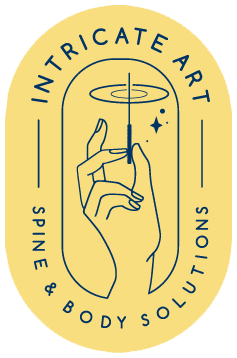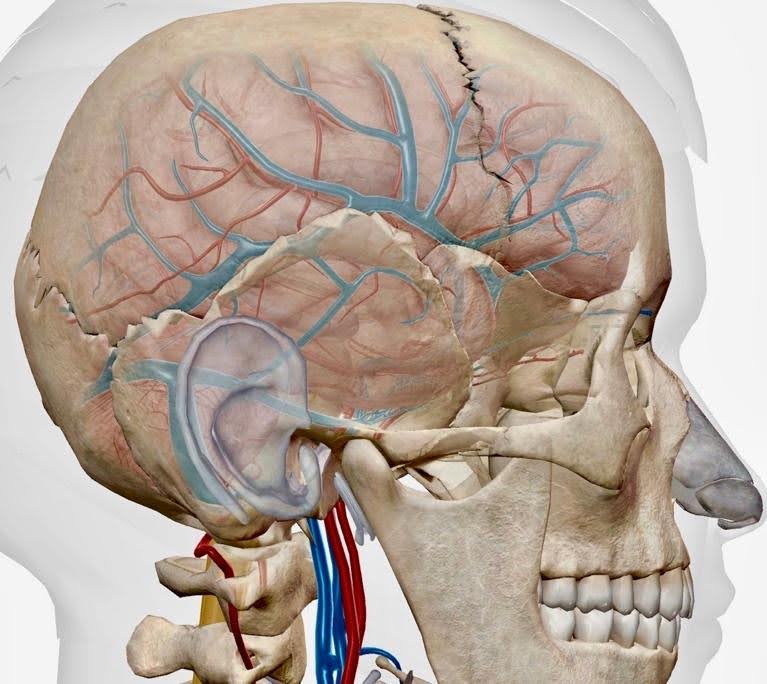
Concussions: Dry Needling & Joint Manipulation to Help Treat & Resolve Impaired Brain Function
Concussions lead to an overall decrease in blood perfusion and impaired neuronal function in the brain. Some neurons become hyperactive, others become hypoactive, resulting in autonomic nervous system dysregulation tilted toward sympathetic dominance. The same thing typically happens to tissues outside the brain when they get disgruntled. Two of the most objective facts we know about the effects of thoughtful dry needling are it induces increased blood flow and improved neurophysiologic function, both in soft tissues outside the brain, and in the brain itself. On a base level, this occurs by stimulating the body in a direct, specific-enough manner to restore normal communication between brain regions and the corresponding affected structures or processes. It restores the normal balance to both the sympathetic and parasympathetic autonomic nervous systems. Autonomic nervous system homeostasis is the key to healing and maintaining mental and physical health. It allows the brain and body to use the full armory of their innate defenses, without inhibition, to fight off and resist pathology.
Nothing in our body changes on its own without the brain telling it to. Unless some disgruntled giant platypus tramples you, then the jerk-egg-laying-mammal is the root of your problems. In the absence of continued insult or structural damage, the brain and body know how to heal themselves and function properly. The issue is, they get inhibited from using their awesome, innate healing powers secondary to factors stimulating the autonomic nervous system into a chronic state of sympathetic hyperactivity. Without autonomic nervous system homeostasis, our brain and body lose access to their superpowers. This is bad.
Dry needling and joint manipulation both induce some level of direct mechanical alteration of tissue. However, the underlying reason they both work so well when mindfully performed is neurologic, secondary to the mechanical stress. We are using tissue in the body as a means of access to stimulate homeostasis in the brain. This enables proper regulatory communication between various brain regions and corresponding locations in the body, resulting in homeostasis of both the brain and the body.
Remember, the typical human reaction to mental or physical stress, strain, pain, or trauma, is to elevate the sympathetic autonomic nervous system. The overwhelming majority of people in the US are living with chronic sympathetic autonomic nervous system hyperactivity. This means the overwhelming majority of people are living their day-to-day lives feeling like hot garbage, whether they are consciously aware of it or not. The human mind and body have amazing adaptive abilities, even if the adaptation is detrimental to overall wellbeing. This is unfortunate, but don’t lose hope! There are simple tools available to dramatically and naturally improve your mental and physical health.
Related: Sign up for an Online Dry Needling Course Today
If you showed images of a stroke patient’s brain to a brain surgeon, they could hypothesize with some confidence as to what impairments would likely be present in the body, prior to seeing the patient. The reverse holds true as well, and should be taken advantage of to maximize brain health. Unfortunately, people simply do not typically think this way. All nerves are two-way highways, with varying percentages of their fibers responsible for conducting information going to and from the brain, intricately interconnecting certain parts of the body to certain parts of the brain.
If the autonomic nervous system goes over your individual threshold for sympathetic activity, it loses its ability to self-regulate. This leads to our systems becoming energy deficient. Our cells start producing less energy per molecule of glucose processed, our body is less efficient at breaking down food to acquire nutrients, our system and cells run out of energy, and everything gets hypoxic and inflamed. The mitochondria and other organelles in our cells run out of ATP, NADH, NAD+, O2, and other stuff, then our systems have to decide where to send and use the available energy because we no longer have enough to properly deal with everything going on. This is what leads to cancer, autoimmunity, diabetes, hearing loss, chronic pain, mental health problems, and any other nasty thing you can think about, including impaired recovery from concussion, and the likelihood of experiencing a concussion in the first place.
The trick is, figuring out how to put gas back in the generator, energy back in the battery. Although the brain is only about 2% of our body weight, it uses about 20% of our body wide energy stores to function optimally. Some people use even more of their total energy to run the brain, like people with concussions. Therefore, one of the primary aims of concussion treatment should be to restore as much energy availability to the brain as possible, which physical therapists can accomplish by removing as much tissue pathology from the body as possible. If you simultaneously target the parasympathetic portion of the autonomic nervous system, we restore maximal energy to our autonomic well of healing power. The best ways we can do this are thoughtful dry needling combined with joint manipulation, along with consistent exercise, eating well, proper supplementation, and sleeping well. Unfortunately, most Americans do not do the last 4.
If you want some awesome information about why exercise, diet, and sleep are so important, check out Dr. Peter Attia (The Drive Podcast: https://peterattiamd.com/podcast/) and Dr. Rhonda Patrick (Found My Fitness Podcast: https://www.foundmyfitness.com/episodes). When I am teaching other doctors or treating patients, I make it a point to spend as much time as needed talking to them about potential ways to improve their diet, properly supplement, exercise, and how to test and monitor their individual genetics, epigenetics, and nutrient levels. Again, these are, by far, the easiest ways to improve and maintain your own health.
However, I try to live in reality, not some delusional, make-believe world. The simple fact of the matter is, the vast majority of people will never exercise or eat well for more than a week or two at a time. So, I take as much time as needed to relay the importance of those things and how to accomplish them. Then I leave that part of the equation up to them, while I chose to spend my time with them removing as many years of pathology from their mind and body as I possibly can, because most people cannot or will not accomplish that on their own. This will also improve the chances of them exercising, because they will hurt less and feel better, mentally and physically.
Every tiny piece of normalized soft tissue, every normalized joint, every millimeter of normalized capsular tissue, removes stress from the autonomic nervous system and gives energy back to it, which improves cerebral blood perfusion and helps to restore normal neuronal activity. If you restore enough energy to the autonomic nervous system, the mind and body break out of their inhibited state and are able to direct ample resources to fix ongoing problems. I think of it as running an antivirus program on the computer. Barring specific, ongoing injury, almost all “idiopathic” impairments have a root cause of autonomic nervous system energy deficiency and a departure from homeostasis. Rather than trying to fix specific impairments, if we try to fix the autonomic nervous system, we allow the brain and body to fix themselves. Trust me, our systems know how to fix themselves far better than we ever will. We just need to remove the stuff inhibiting them from doing so.
Below is a picture of the homunculus, generally outlining which parts of the motor cortex are connected to certain body regions.
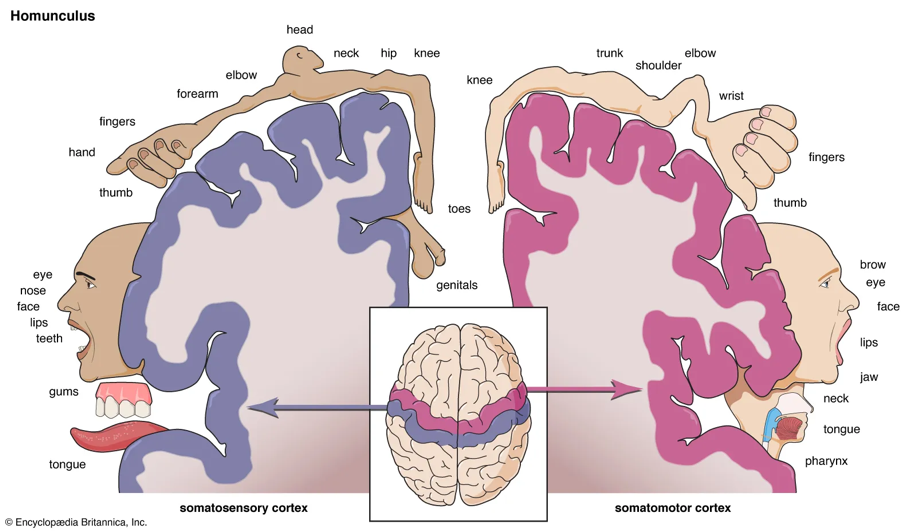
Remember, we know very little about the brain and body, in comparison to everything we could possibly know. We know treating body regions has homeostatic effects outside the motor cortex as well, although the relationships are not extremely clear. Many medical “facts” practitioners accept to be true across the board for all patients, actually vary significantly on an individual basis. A lot of what is accepted as fact is completely erroneous, like the FDA food pyramid, which couldn’t be farther from the truth. Regardless of how accurate we are able to map the brain, the general concept holds true. Certain areas of the brain work to control certain areas of the body, and all the parts of the brain and body need to work in conjunction with each other, to varying degrees, to achieve optimal mental and physical health. Just like bodily dysfunction observed secondary to concussion or stroke, pathology in the body causes a departure from homeostasis and pathologic function in the corresponding sections of the brain.
Just because a concussion is typically due to getting bonked in the head, this in no way indicates all concussion treatment should be laser focused on treating the head. This is the same mistake mainstream medicine makes with almost all other impairments. They see an organ or tissue dysfunction, and they target the symptoms, to the exclusion of all else. The issue with this is, the organ itself is rarely the underlying cause of the problem. If you don’t treat the cause, the problem never goes away. This is why there are almost zero cures for anything, if you are being treated in mainstream medicine. We know for a fact, objectively observable on fMRI, that normalizing certain regions of the body normalizes certain regions of the brain. Take urinary incontinence, for example.
The most effective treatment for incontinence, by far, is dry needling combined with joint manipulation, because of their potent regulatory effects on the brain and the autonomic nervous system. Randomized control trials have shown about an 80% significant improvement or complete resolution rate of urinary incontinence with electrical dry needling techniques focused on changing the brain, specifically, the pontine micturition center (PMC) in the pons.
This can be accomplished in about 6 weeks of treatment, 1-2 times a week. Typical expensive pharmaceuticals with a ton of side effects are about 30% less effective and you have to take them for life. This is because they are not addressing the cause of the problem, which is sympathetic autonomic hyperactivity. They address the symptom, incontinence, by relaxing the bladder and associated muscles, but do nothing to address why the muscles and organ are sympathetically hyperactive in the first place.
Post-concussion, the brain has already received the initial insult, now it needs to heal, that’s it. Our brain knows how to heal. The problem is, any pathology in the rest of our body is taking energy the brain could be using to heal. When tissue is damaged, it requires extra energy from the well of autonomic nervous system. If the well is dry, or the available energy well is insufficient, healing is inhibited, or stopped all together. This is the same exact reason the 50% of 65 year olds who break their hip are dead within 5 years.
Breaking your hip, on its own, is typically not life threatening. I broke my hip 20 years ago, and I’m still alive and kicking! Most people are not healthy, primarily from a lack of exercise and eating processed foods, especially as we age. When you are not healthy, your body and brain have too much going on to be able to properly utilize its energy resources, and the energy resources are dwindled. If you add a sudden, traumatic event that requires a lot of energy to heal, to an unhealthy mind and body, you go into energy crisis and everything gets worse, including brain function. Now, whether you are super healthy or not, the brain requires a lot of energy, especially when it needs to heal from trauma. The more energy you can restore to the brain and autonomic nervous system by removing pathologic tissues sucking up that energy, the faster and better the brain and body can heal.
Below is a nice chart of some general tendencies in a post-TBI (concussion) brain. Mind you, very similar things happen to our other tissues when the sympathetic nervous system becomes hyperactive.

Romeu-Mejia, R., Giza, C.C. and Goldman, J.T., 2019. Concussion pathophysiology and injury biomechanics. Current reviews in musculoskeletal medicine, 12, pp.105-116.
Trigeminocervical Complex Impairment
In the picture below of the brain, the very bottom black dot labeled “TCC” is the trigeminocervical nucleus at C2. If C1/C2, the most mobile segment of our spine, becomes deviated from direct external force or compensation, the sympathetic chain all the way to the coccyx receives abnormal stress placed upon it, resulting in widespread panic of our nervous systems. Now, the two primary parasympathetic portions of the spinal cord become pathologic, the sacral plexus (S2-S4), and the upper cervical spine (secondary to cranial nerves V, VII, IX, X). Remember, in general, pathology anywhere in the body stimulates the sympathetic autonomic nervous system to elevate, which reciprocally inhibits, or depresses, the parasympathetic portion of the autonomic nervous system.
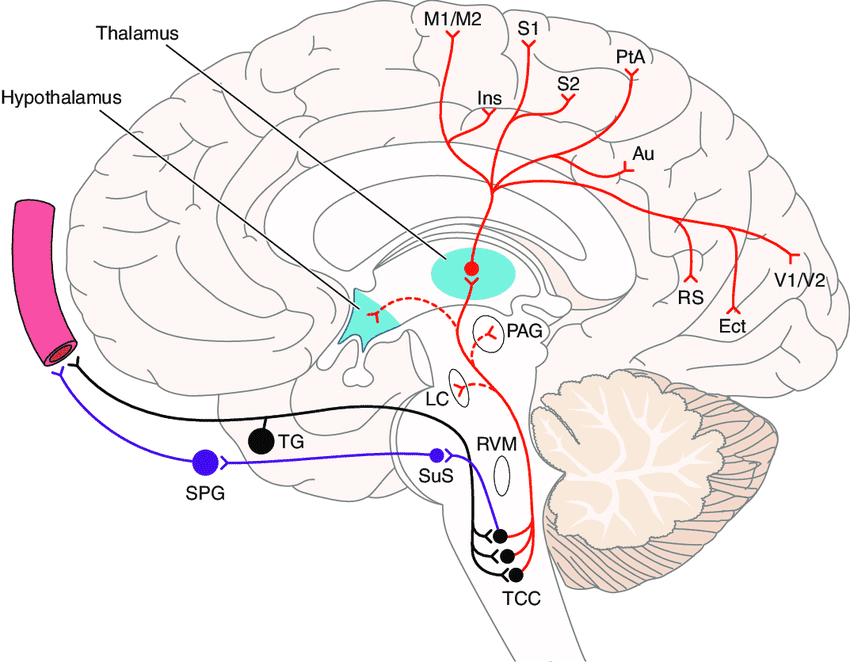
DOI: 10.1152/physrev.00034.2015
C2 is an excellent region to target numerous muscles that are often angry following concussion. These muscles are pathologic in most people, even without getting your brain addled, and they can impair the trigeminocervical complex even in the absence of concussion. The following muscles attach on C2: multifidus, middle scalene, inferior oblique, rectus capitis posterior major, semispinalis cervicis, splenius cervicis, levator scapula, and the upper trap through the nuchal ligament. That’s all the major ones, I think. With enough Pathologic afferent nervous signals coming from the muscles, tendons, and ligaments around C2, the many important structures in the nearby brain stem “short circuit”, if you will. We are unsure exactly how the disruption takes place, but there is strong objective evidence that if the subcranial muscles get grumpy enough, things like the trigeminocervical nucleus in the dorsal horn of the spinal cord at C2, the thalamus, hypothalamus, pituitary, and other nearby cerebral structures depart from homeostasis and begin to dysfunction.
The primary nerve of the parasympathetic autonomic nervous system is the vagus nerve, cranial nerve X, the “wandering nerve.” The vagus nerve is the connector between the gut and the brain (gut-brain axis), the adrenal glands and the brain (hypothalamic-pituitary-adrenal axis), and is the primary information highway between the rest of our organs and our brain. 80% of the vagus fibers are afferent, meaning the top priority of the vagus is to tell the brain what is going on with the organs, so the brain can process the information and respond by sending the necessary controlling stimuli. Another term is interoceptive awareness. If the sympathetic nervous system is hyperactive, as it is in the majority of humanity secondary to processed foods and a lack of activity, the most negatively affected structure is going to be the most parasympathetic-dominant structure in the body, the vagus nerve. Think about that for a sec… Eating the typical American diet produces similar circumstances in the brain as does getting smoked in the head by a leaping spotted stingray while driving a boat 30 miles an hour in Florida… Disturbing.
The more parasympathetic the structure, the more inhibition secondary to sympathetic hyperactivity. Remember, sympathetic hyperactivity is the natural human response to mental and physical stress, strain, pain, and trauma, including concussions. When the vagus nerve is inhibited, the brain receives faulty information about the organs and itself. Without proper information coming in, the brain is unable to send the correct regulating response signals back to the organs and other brain regions. This can lead to about any physical or mental impairment you can think of, including dementia, tinnitus, hearing loss, DNA-RNA-protein misfolding, brain plaques, neuropathy, pain, brain fog, chronic fatigue, dizziness, anxiety, and depression, all of which also happen to be potential side effects of concussions.
The trigeminal nerve, Cranial nerve V, is a nerve with strong parasympathetic ganglia in the brain. Many of the points of connection in the trigeminocervical complex intricately interconnect with the hypothalamic-pituitary-adrenal (HPA) axis. If these axes start receiving hyperactive sympathetic stimulation, the concentrations of all our hormones, endogenous opioids, and neuromodulators become abnormal. Cerebral and somatic blood perfusion slows down, and abnormal neuronal function ensues. This is a reason why it is so important to always target parasympathetic portions of the autonomic nervous system, including the vagus nerve distribution in the ear, the trigeminal nerve in the face, and the sacral plexus, along with whatever else you are treating. And whatever else you are treating should include all tissue pathology throughout the body, regardless of where the primary insult is, although that is obviously an area of import. This treatment methodology restores as much energy to the autonomic nervous system as we can with the tools at our disposal as physical therapists. This is energy the brain requires to heal as quickly and completely as possible.
Related: My Overview Article on how Dry Needling Works
Vagus & Trigeminal Nerves
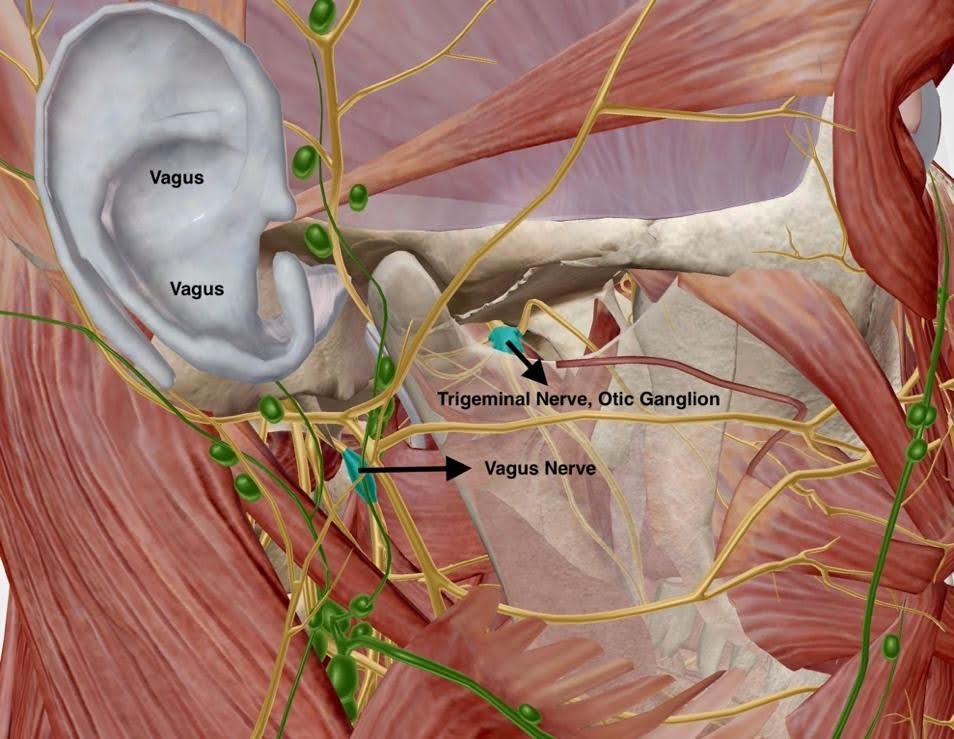
We want to maintain as much reserve energy in our autonomic well as we can, to both maintain health and heal from injury. Epigenetic blood testing and gene testing can easily be performed to establish your personal situation, and with the help of someone with the proper knowledge, you can use that information to alter your diet, supplementation, and health. It is important to properly test to get your baseline levels, then retest consistently to monitor your brain and body’s reaction to your thoughtful intervention. This allows you to adjust as needed to reach your true health potential. If you add in consistent exercise, along with thoughtful dry needling and joint manipulation to ameliorate the physical and mental wear and tear of everyday living on the autonomic nervous system, we put our brain and body in the most advantageous position to achieve maximum homeostasis and function. This thought process should be utilized to both induce healing and to prevent disease from occurring in the first place.
As far as concussions are concerned, every needle placed into pathologic tissue anywhere in the body, any joint restored to neutral orientation, restores energy, homeostasis, and healing powers to the brain. Some areas, like the parasympathetic-dominant portions of the spinal cord and the tissues they innervate, appear to generate extra-super-awesome (real medical term) homeostatic effects in the brain, which should not be surprising, since the human nervous system has a strong affinity to tilt in the sympathetic direction when aggravated, especially when the brain gets bonked. Overall, dry needling combined with joint manipulation nudge the autonomic nervous system toward homeostasis. I don’t know of any mental or physical impairment that does worse with a more homeostatic nervous system. This is why these treatments should be more widely used in medicine, including in the treatment of concussions.
DISCLAIMER: The content on the blog for Intricate Art Spine & Body Solutions, LLC is for educational and informational purposes only, and is not intended as medical advice. The information contained in this blog should not be used to diagnose, treat or prevent any disease or health illness. Any reliance you place on such information is therefore strictly at your own risk. Please consult with your physician or other qualified healthcare professional before acting on any information presented here.
References
- Caccese, J.B., Houck, Z., Kaminski, T.W., Clugston, J.R., Iverson, G.L., Bryk, K.N., Oldham, J.R., Pasquina, P.F., Broglio, S.P., McAllister, T.W. and McCrea, M., 2020. Estimated age of first exposure to American football and outcome from concussion. Neurology, 95(21), pp.e2935-e2944.
- Eagle, S.R., Kontos, A.P., Collins, M.W., Connaboy, C. and Flanagan, S.D., 2021. Network Analysis of Sport-Related Concussion Research During the Past Decade (2010–2019). Journal of athletic training, 56(4), pp.396-403.
- Kantorski, B., Commisso, D.R., Sanford-Dolly, C.W. and Pollock, J.A., 2020. The use of a mobile application to teach concussion-related health knowledge. Journal of STEM outreach, 3(1).
- Romeu-Mejia, R., Giza, C.C. and Goldman, J.T., 2019. Concussion pathophysiology and injury biomechanics. Current reviews in musculoskeletal medicine, 12, pp.105-116.
- Howell, D.R. and Southard, J., 2021. The molecular pathophysiology of concussion. Clinics in sports medicine, 40(1), pp.39-51.
- Mares, C., Dagher, J.H. and Harissi-Dagher, M., 2019. Narrative review of the pathophysiology of headaches and photosensitivity in mild traumatic brain injury and concussion. Canadian journal of neurological sciences, 46(1), pp.14-22.
- Wangui, A.M., Kaniaru, D. and Wambui, M., 2019. Pathophysiology and mechanism of concussion. Journal of Advances in Sports and Physical Education.
- Chen, Y., Herrold, A.A., Gallagher, V.T., Reilly, J.L., Parrish, T. and Breiter, H.C., 2019. Cutting to the pathophysiology chase: translating cutting-edge neuroscience to rehabilitation practice in sports-related concussion management. journal of orthopaedic & sports physical therapy, 49(11), pp.811-818.
- Hicks, S.D., Olympia, R.P., Onks, C., Kim, R.Y., Zhen, K.J., Fedorchak, G., DeVita, S., Rangnekar, A., Heller, M., Zwibel, H. and Monteith, C., 2020. Saliva microRNA biomarkers of cumulative concussion. International journal of molecular sciences, 21(20), p.7758.
- Satarasinghe, P., Hamilton, D.K., Buchanan, R.J. and Koltz, M.T., 2019. Unifying pathophysiological explanations for sports-related concussion and concussion protocol management: literature review. Journal of experimental neuroscience, 13, p.1179069518824125.
- Butt, M.F., Albusoda, A., Farmer, A.D. and Aziz, Q., 2020. The anatomical basis for transcutaneous auricular vagus nerve stimulation. Journal of anatomy, 236(4), pp.588-611.
- Austelle, C.W., O'Leary, G.H., Thompson, S., Gruber, E., Kahn, A., Manett, A.J., Short, B. and Badran, B.W., 2022. A comprehensive review of vagus nerve stimulation for depression. Neuromodulation: Technology at the Neural Interface, 25(3), pp.309-315.
- Dawson, J., Liu, C.Y., Francisco, G.E., Cramer, S.C., Wolf, S.L., Dixit, A., Alexander, J., Ali, R., Brown, B.L., Feng, W. and DeMark, L., 2021. Vagus nerve stimulation paired with rehabilitation for upper limb motor function after ischaemic stroke (VNS-REHAB): a randomised, blinded, pivotal, device trial. The Lancet, 397(10284), pp.1545-1553.
- Bonaz, B., Sinniger, V. and Pellissier, S., 2021. Therapeutic potential of vagus nerve stimulation for inflammatory bowel diseases. Frontiers in neuroscience, 15, p.650971.
- Churchill, N.W., Hutchison, M.G., Graham, S.J. and Schweizer, T.A., 2020. Baseline vs. cross-sectional MRI of concussion: distinct brain patterns in white matter and cerebral blood flow. Scientific reports, 10(1), p.1643.
- Ulyanova, A.V., Cottone, C., Adam, C.D., Maheshwari, N., Grovola, M.R., Fruchet, O.E., Alamar, J., Koch, P.F., Johnson, V.E., Cullen, D.K. and Wolf, J.A., 2022. Hippocampal Interneuronal Dysfunction and Hyperexcitability in a Porcine Model of Concussion. bioRxiv, pp.2022-03.
- Amjad, S., Nisar, S., Bhat, A.A., Frenneaux, M.P., Fakhro, K., Haris, M., Reddy, R., Patay, Z., Baur, J. and Bagga, P., 2021. Role of NAD+ in regulating cellular and metabolic signaling pathways. Molecular Metabolism, 49, p.101195.
- Peters, K.M., MacDiarmid, S.A., Wooldridge, L.S., Leong, F.C., Shobeiri, S.A., Rovner, E.S., Siegel, S.W., Tate, S.B., Jarnagin, B.K., Rosenblatt, P.L. and Feagins, B.A., 2009. Randomized trial of percutaneous tibial nerve stimulation versus extended-release tolterodine: results from the overactive bladder innovative therapy trial. The Journal of urology, 182(3), pp.1055-1061.
- Resting-State fMRI in Studies of Acupuncture. Evid Based Complement Alternat Med. 2021; 2021: 6616060. Published online 2021 Mar 23. doi: 10.1155/2021/6616060
